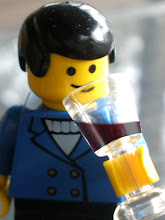
I recently had the opportunity to sample wines from The Ed's Enomatic wine tasting machine, or, the Wine Taster 2000 as it could also be called. :)
For those unfamiliar with the machine, The Enomatic is a wine dispenser, capable of rationing out single tastings, double tastings or full glasses of wine, via 3 separate buttons aligned to each bottle in the display. Prices go up in accordance with the size of the pour, as well as the wine in question. Additionally, and on this day, some pours can be free of charge, however, it's intended for commercial use and not the home (although...).
To prevent oxidation, the Enomatic disperses gas into the bottle as it pours out the wine. In this case, The Ed were using argon, which can apparently keep open wine bottles fresh for around a month, but to play it safe, bottles at The Ed are presently changed over after two weeks. Seeing as single bottles actually last two weeks, indicates to me there might not be too much consumer interest in the Enomatic around Adelaide, just yet.
I tasted my way through the wines available on the day, which included a couple of Australian icons. Leeuwin Estate's 2008 Art Series Chardonnay, Clonakilla's 2009 Shiraz Viognier and Peter Lehmann's 2006 Stonewell were all on hand, but alas, they were also at the end of their two week cycle, as they were getting replaced by a predominantly European selection of off-dry rieslings the next day.
To be honest, I felt some of the wines presented well and some not so well, so no tasting notes were taken. I believe the level of wine in the bottle may have had some effect, as some of the cheaper wines (including Rymill's 'free of charge' 2008 Cabernet Sauvignon) appeared fresher and livelier through the palate. Interestingly, a staff member agreed some of the wines may have been a bit 'flat'. To possibly improve the situation, the next selection of wines are going to be 'prolonged' by a mixture of argon and CO2. It's still a trial and error thing at the moment, as well as the only one in Adelaide if I'm correct. If anyone out there has any experience using these machines, any insight would be appreciated.
To purchase from the Enomatic, The Ed provides the customer/taster with a 'credit card', where credits can be purchased and topped up from the register as you see fit. Knowing the place, I can guarantee there will always be something interesting in their Enomatic, but whether you're willing to pay for it is up to you.
As a rough guideline of pricing, I think the Art Series was $4 a pour, $8 a double and $18 a glass. Clonakilla $4.50 a pour, $9 a double and $20 a glass. You be the judge. Most days I'd be happy to pay $18 for a glass of Art Series or $20 for Clonakilla, but with Enomatic, I just wasn't convinced about the state of the wine's freshness, or the environment in which it's presented (does anyone really want to pay $20 for a glass of wine in a bottle shop?) I'd want to get there early on the rotation next time, although I was told the Art Series was drinking better after two weeks.

The Ed's Enomatic credit card
So there we have it. More innovation from my favourite fine wine retailer. Is it the future of wine drinking? I hope not. But I don't have a problem with Enomatic playing its role at fine wine retailers or wine bars. Sure, the prolonged freshness is a plus and allowing customers to taste wines they otherwise might not buy is good (the first set of wines included Hill of Grace, Grange and Chateau d'Yquem - too many credits for me!), but the Enomatic experience is just too sterile for me, and as a consumer, it also takes away one of my most loved aspects of wine tasting; human to human contact.
For more information check out:-
Is there no Australian site?


 - Clare Valley, SA
- Clare Valley, SA - Rutherglen, VIC
- Rutherglen, VIC - Padthaway, SA
- Padthaway, SA - McLaren Vale, SA
- McLaren Vale, SA

 - Canberra District
- Canberra District - Canberra District
- Canberra District - McLaren Vale, SA
- McLaren Vale, SA - Margaret River, WA
- Margaret River, WA - King Valley, VIC
- King Valley, VIC - Margaret River, WA
- Margaret River, WA - Barossa Valley, SA
- Barossa Valley, SA - Adelaide Hills, SA
- Adelaide Hills, SA - Orange, NSW
- Orange, NSW - Yarra Valley, VIC
- Yarra Valley, VIC - Barossa Valley, SA
- Barossa Valley, SA